World Trade Organization Project: BFM Semester 1 Analysis
VerifiedAdded on 2022/09/14
|14
|2526
|32
Project
AI Summary
This project, submitted by a BFM student at K.E.S B.K. Shroff College, provides a comprehensive overview of the World Trade Organization (WTO). It begins with an introduction to the WTO, its origins as a successor to GATT, and its role in managing global trade. The project outlines the objectives of the study, including understanding the functions, principles, structure, and agreements (TRIPS, TRIMs) of the WTO. The main content includes a fact file, a detailed discussion of the WTO's role, structure, functions, and principles, such as non-discrimination, freer trade, and predictability. The project further explores the TRIMs and TRIPS agreements, key objectives, and the WTO's dispute settlement mechanism. It also includes a section on various agreements and criticisms of the WTO. Overall, the project aims to provide a thorough understanding of the WTO's impact on international trade and its role in the global economy.
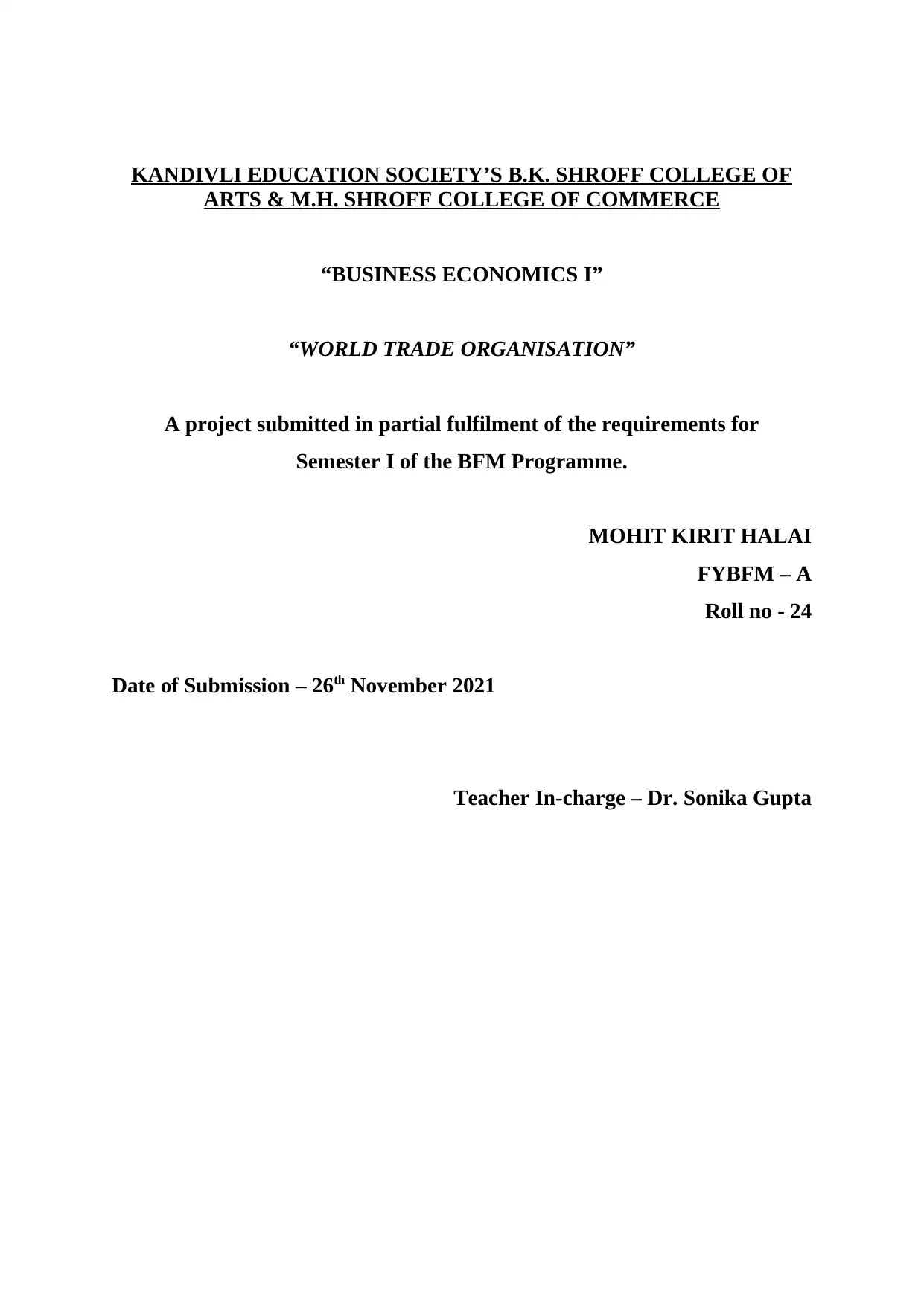
KANDIVLI EDUCATION SOCIETY’S B.K. SHROFF COLLEGE OF
ARTS & M.H. SHROFF COLLEGE OF COMMERCE
“BUSINESS ECONOMICS I”
“WORLD TRADE ORGANISATION”
A project submitted in partial fulfilment of the requirements for
Semester I of the BFM Programme.
MOHIT KIRIT HALAI
FYBFM – A
Roll no - 24
Date of Submission – 26th November 2021
Teacher In-charge – Dr. Sonika Gupta
ARTS & M.H. SHROFF COLLEGE OF COMMERCE
“BUSINESS ECONOMICS I”
“WORLD TRADE ORGANISATION”
A project submitted in partial fulfilment of the requirements for
Semester I of the BFM Programme.
MOHIT KIRIT HALAI
FYBFM – A
Roll no - 24
Date of Submission – 26th November 2021
Teacher In-charge – Dr. Sonika Gupta
Paraphrase This Document
Need a fresh take? Get an instant paraphrase of this document with our AI Paraphraser
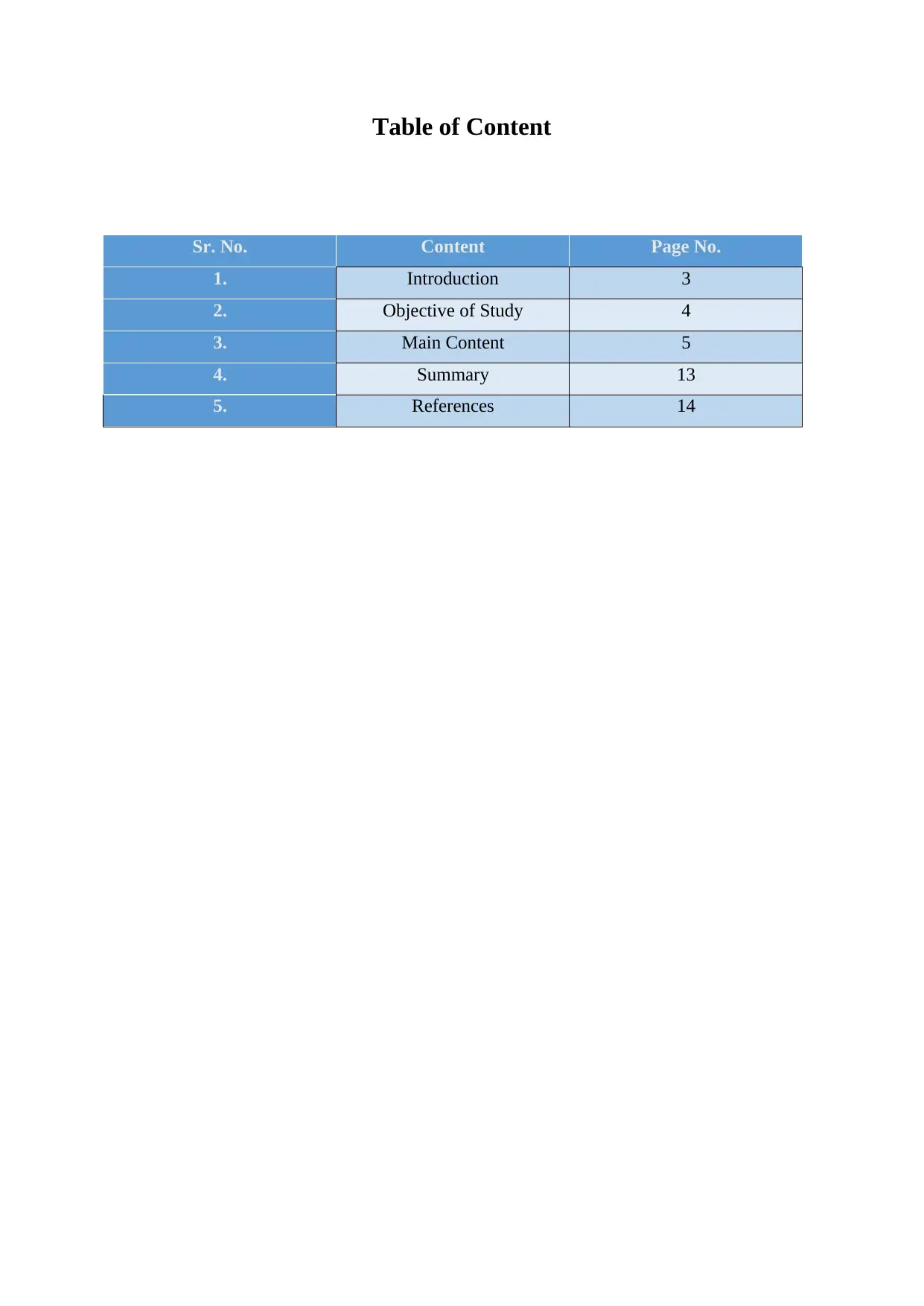
Table of Content
Sr. No. Content Page No.
1. Introduction 3
2. Objective of Study 4
3. Main Content 5
4. Summary 13
5. References 14
Sr. No. Content Page No.
1. Introduction 3
2. Objective of Study 4
3. Main Content 5
4. Summary 13
5. References 14
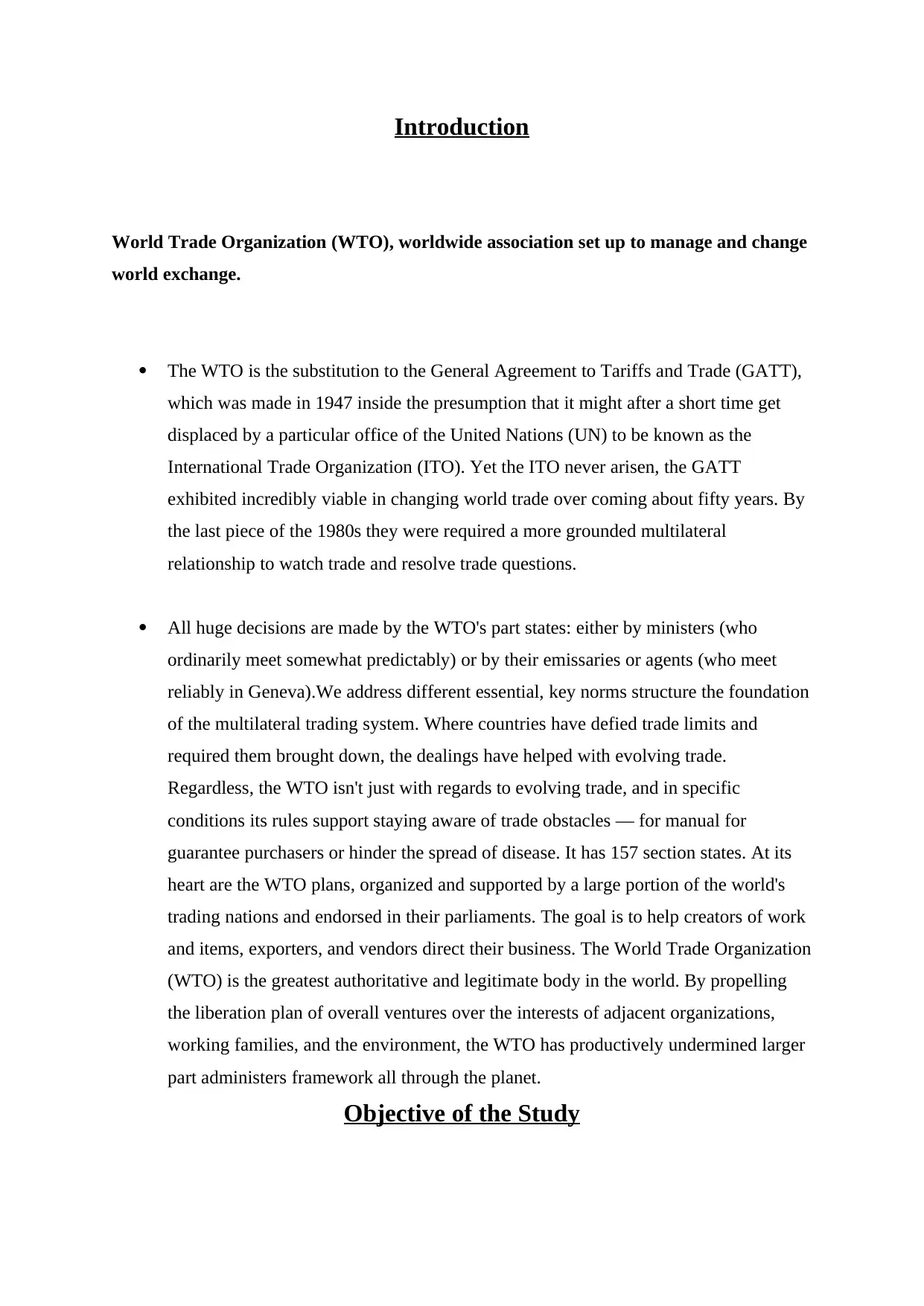
Introduction
World Trade Organization (WTO), worldwide association set up to manage and change
world exchange.
The WTO is the substitution to the General Agreement to Tariffs and Trade (GATT),
which was made in 1947 inside the presumption that it might after a short time get
displaced by a particular office of the United Nations (UN) to be known as the
International Trade Organization (ITO). Yet the ITO never arisen, the GATT
exhibited incredibly viable in changing world trade over coming about fifty years. By
the last piece of the 1980s they were required a more grounded multilateral
relationship to watch trade and resolve trade questions.
All huge decisions are made by the WTO's part states: either by ministers (who
ordinarily meet somewhat predictably) or by their emissaries or agents (who meet
reliably in Geneva).We address different essential, key norms structure the foundation
of the multilateral trading system. Where countries have defied trade limits and
required them brought down, the dealings have helped with evolving trade.
Regardless, the WTO isn't just with regards to evolving trade, and in specific
conditions its rules support staying aware of trade obstacles — for manual for
guarantee purchasers or hinder the spread of disease. It has 157 section states. At its
heart are the WTO plans, organized and supported by a large portion of the world's
trading nations and endorsed in their parliaments. The goal is to help creators of work
and items, exporters, and vendors direct their business. The World Trade Organization
(WTO) is the greatest authoritative and legitimate body in the world. By propelling
the liberation plan of overall ventures over the interests of adjacent organizations,
working families, and the environment, the WTO has productively undermined larger
part administers framework all through the planet.
Objective of the Study
World Trade Organization (WTO), worldwide association set up to manage and change
world exchange.
The WTO is the substitution to the General Agreement to Tariffs and Trade (GATT),
which was made in 1947 inside the presumption that it might after a short time get
displaced by a particular office of the United Nations (UN) to be known as the
International Trade Organization (ITO). Yet the ITO never arisen, the GATT
exhibited incredibly viable in changing world trade over coming about fifty years. By
the last piece of the 1980s they were required a more grounded multilateral
relationship to watch trade and resolve trade questions.
All huge decisions are made by the WTO's part states: either by ministers (who
ordinarily meet somewhat predictably) or by their emissaries or agents (who meet
reliably in Geneva).We address different essential, key norms structure the foundation
of the multilateral trading system. Where countries have defied trade limits and
required them brought down, the dealings have helped with evolving trade.
Regardless, the WTO isn't just with regards to evolving trade, and in specific
conditions its rules support staying aware of trade obstacles — for manual for
guarantee purchasers or hinder the spread of disease. It has 157 section states. At its
heart are the WTO plans, organized and supported by a large portion of the world's
trading nations and endorsed in their parliaments. The goal is to help creators of work
and items, exporters, and vendors direct their business. The World Trade Organization
(WTO) is the greatest authoritative and legitimate body in the world. By propelling
the liberation plan of overall ventures over the interests of adjacent organizations,
working families, and the environment, the WTO has productively undermined larger
part administers framework all through the planet.
Objective of the Study
⊘ This is a preview!⊘
Do you want full access?
Subscribe today to unlock all pages.

Trusted by 1+ million students worldwide
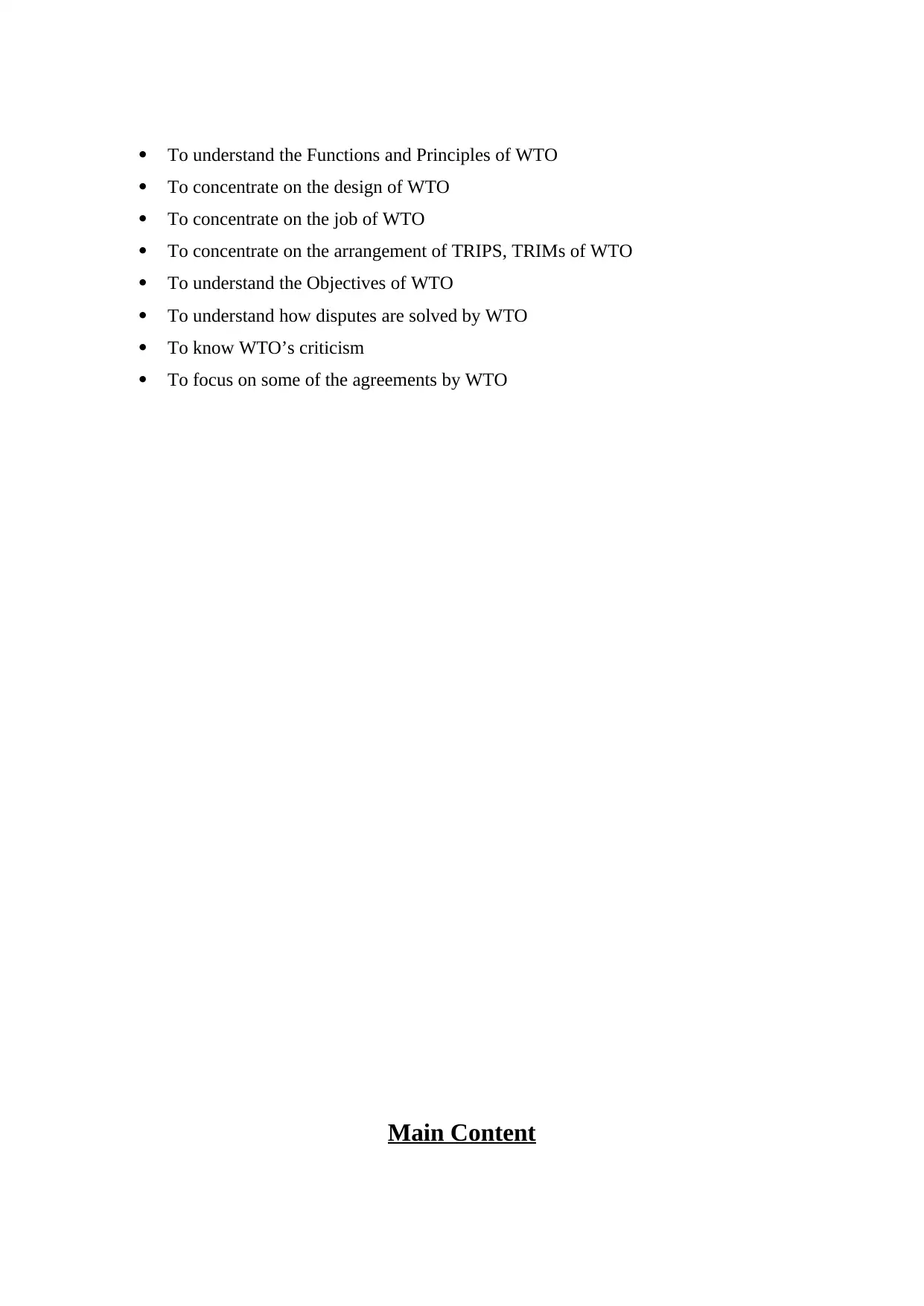
To understand the Functions and Principles of WTO
To concentrate on the design of WTO
To concentrate on the job of WTO
To concentrate on the arrangement of TRIPS, TRIMs of WTO
To understand the Objectives of WTO
To understand how disputes are solved by WTO
To know WTO’s criticism
To focus on some of the agreements by WTO
Main Content
To concentrate on the design of WTO
To concentrate on the job of WTO
To concentrate on the arrangement of TRIPS, TRIMs of WTO
To understand the Objectives of WTO
To understand how disputes are solved by WTO
To know WTO’s criticism
To focus on some of the agreements by WTO
Main Content
Paraphrase This Document
Need a fresh take? Get an instant paraphrase of this document with our AI Paraphraser
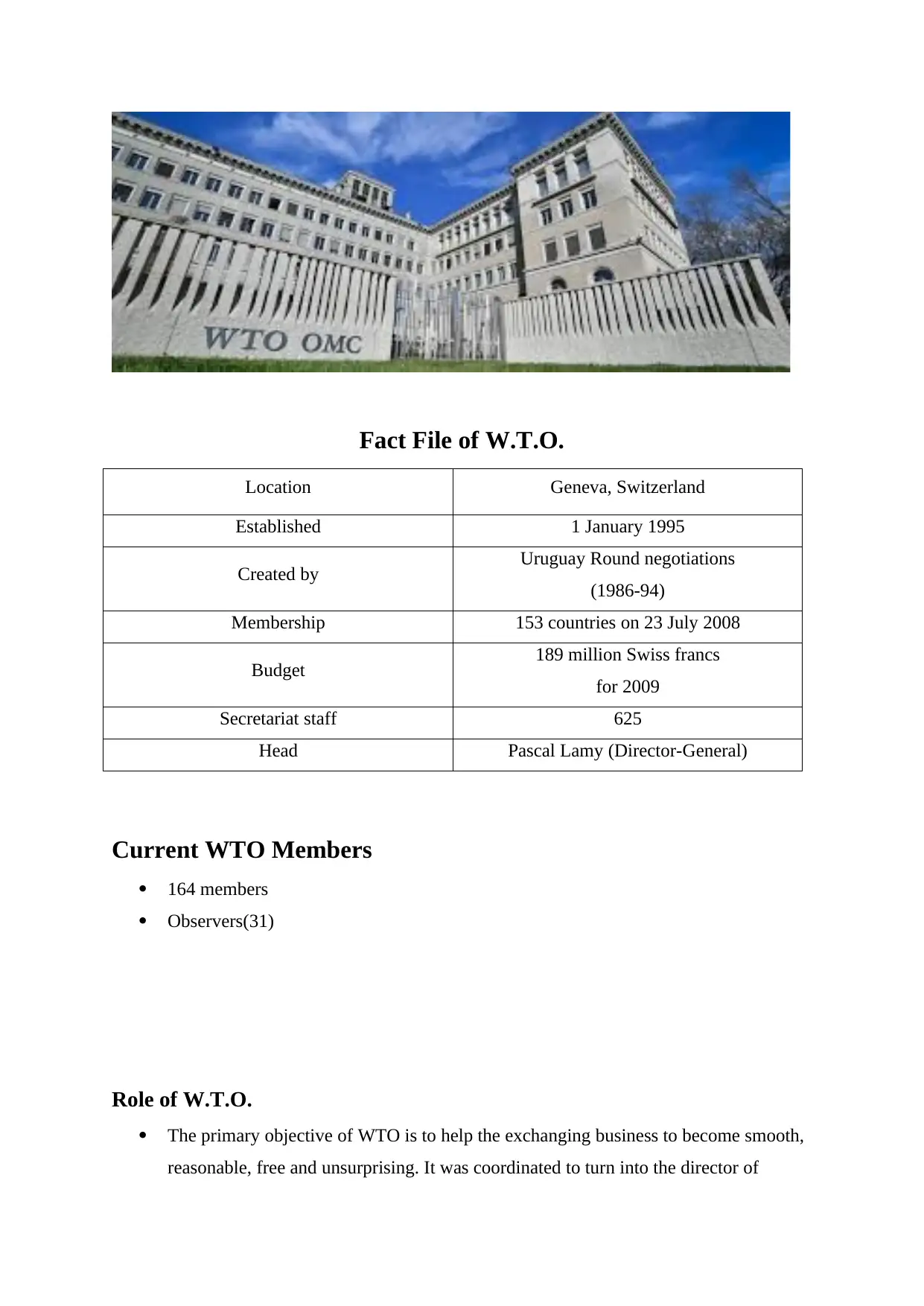
Fact File of W.T.O.
Location Geneva, Switzerland
Established 1 January 1995
Created by Uruguay Round negotiations
(1986-94)
Membership 153 countries on 23 July 2008
Budget 189 million Swiss francs
for 2009
Secretariat staff 625
Head Pascal Lamy (Director-General)
Current WTO Members
164 members
Observers(31)
Role of W.T.O.
The primary objective of WTO is to help the exchanging business to become smooth,
reasonable, free and unsurprising. It was coordinated to turn into the director of
Location Geneva, Switzerland
Established 1 January 1995
Created by Uruguay Round negotiations
(1986-94)
Membership 153 countries on 23 July 2008
Budget 189 million Swiss francs
for 2009
Secretariat staff 625
Head Pascal Lamy (Director-General)
Current WTO Members
164 members
Observers(31)
Role of W.T.O.
The primary objective of WTO is to help the exchanging business to become smooth,
reasonable, free and unsurprising. It was coordinated to turn into the director of
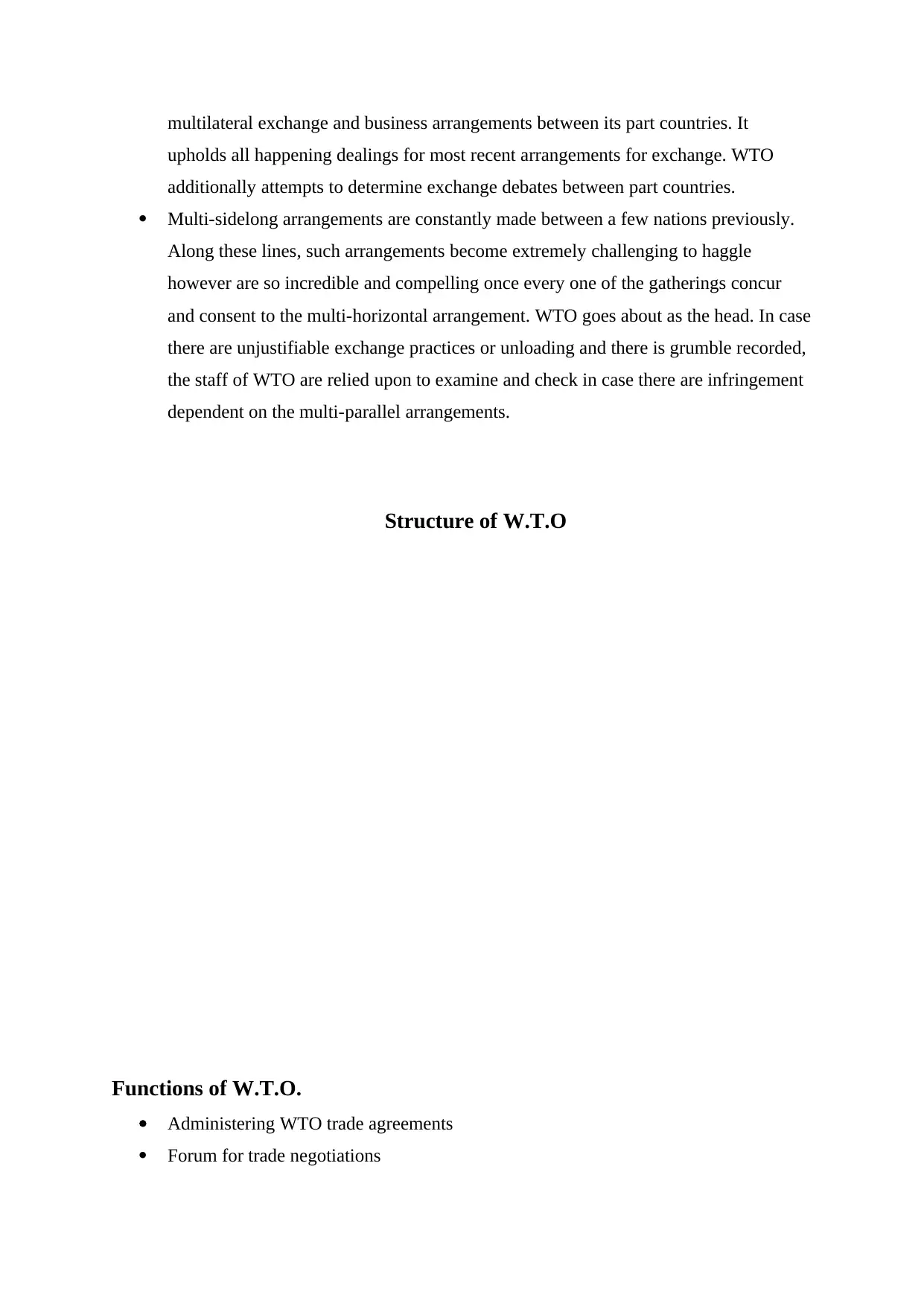
multilateral exchange and business arrangements between its part countries. It
upholds all happening dealings for most recent arrangements for exchange. WTO
additionally attempts to determine exchange debates between part countries.
Multi-sidelong arrangements are constantly made between a few nations previously.
Along these lines, such arrangements become extremely challenging to haggle
however are so incredible and compelling once every one of the gatherings concur
and consent to the multi-horizontal arrangement. WTO goes about as the head. In case
there are unjustifiable exchange practices or unloading and there is grumble recorded,
the staff of WTO are relied upon to examine and check in case there are infringement
dependent on the multi-parallel arrangements.
Structure of W.T.O
Functions of W.T.O.
Administering WTO trade agreements
Forum for trade negotiations
upholds all happening dealings for most recent arrangements for exchange. WTO
additionally attempts to determine exchange debates between part countries.
Multi-sidelong arrangements are constantly made between a few nations previously.
Along these lines, such arrangements become extremely challenging to haggle
however are so incredible and compelling once every one of the gatherings concur
and consent to the multi-horizontal arrangement. WTO goes about as the head. In case
there are unjustifiable exchange practices or unloading and there is grumble recorded,
the staff of WTO are relied upon to examine and check in case there are infringement
dependent on the multi-parallel arrangements.
Structure of W.T.O
Functions of W.T.O.
Administering WTO trade agreements
Forum for trade negotiations
⊘ This is a preview!⊘
Do you want full access?
Subscribe today to unlock all pages.

Trusted by 1+ million students worldwide
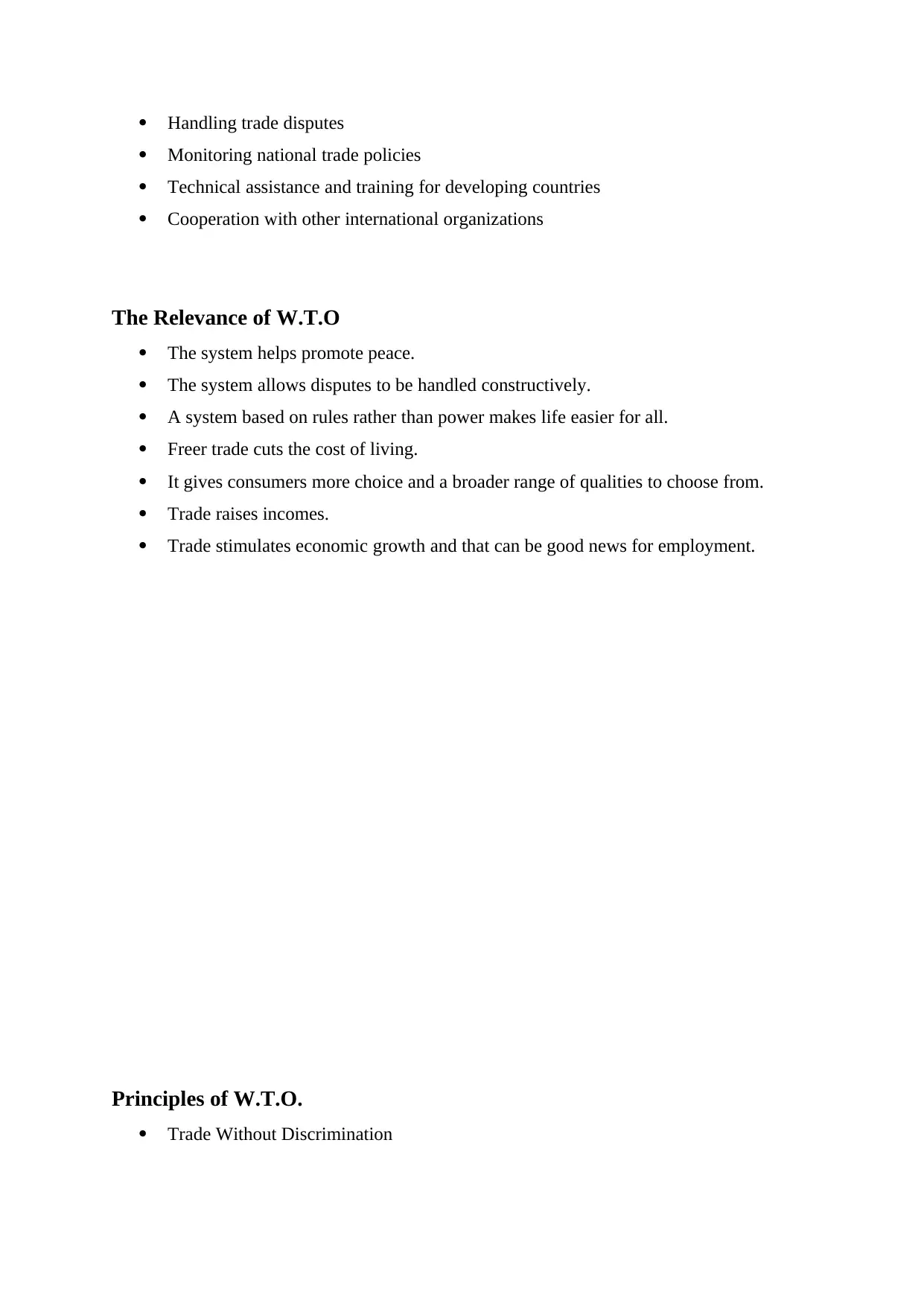
Handling trade disputes
Monitoring national trade policies
Technical assistance and training for developing countries
Cooperation with other international organizations
The Relevance of W.T.O
The system helps promote peace.
The system allows disputes to be handled constructively.
A system based on rules rather than power makes life easier for all.
Freer trade cuts the cost of living.
It gives consumers more choice and a broader range of qualities to choose from.
Trade raises incomes.
Trade stimulates economic growth and that can be good news for employment.
Principles of W.T.O.
Trade Without Discrimination
Monitoring national trade policies
Technical assistance and training for developing countries
Cooperation with other international organizations
The Relevance of W.T.O
The system helps promote peace.
The system allows disputes to be handled constructively.
A system based on rules rather than power makes life easier for all.
Freer trade cuts the cost of living.
It gives consumers more choice and a broader range of qualities to choose from.
Trade raises incomes.
Trade stimulates economic growth and that can be good news for employment.
Principles of W.T.O.
Trade Without Discrimination
Paraphrase This Document
Need a fresh take? Get an instant paraphrase of this document with our AI Paraphraser
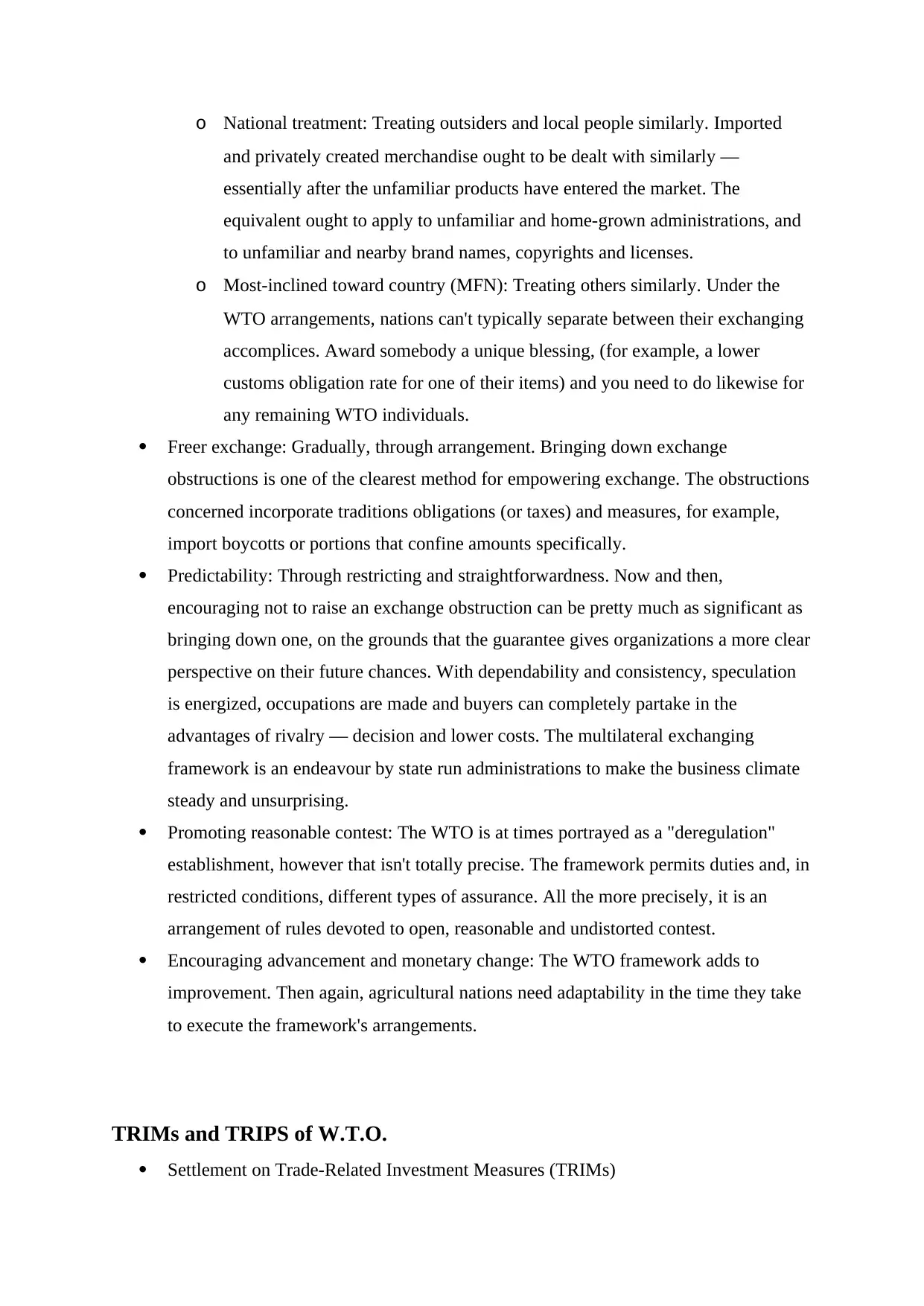
o National treatment: Treating outsiders and local people similarly. Imported
and privately created merchandise ought to be dealt with similarly —
essentially after the unfamiliar products have entered the market. The
equivalent ought to apply to unfamiliar and home-grown administrations, and
to unfamiliar and nearby brand names, copyrights and licenses.
o Most-inclined toward country (MFN): Treating others similarly. Under the
WTO arrangements, nations can't typically separate between their exchanging
accomplices. Award somebody a unique blessing, (for example, a lower
customs obligation rate for one of their items) and you need to do likewise for
any remaining WTO individuals.
Freer exchange: Gradually, through arrangement. Bringing down exchange
obstructions is one of the clearest method for empowering exchange. The obstructions
concerned incorporate traditions obligations (or taxes) and measures, for example,
import boycotts or portions that confine amounts specifically.
Predictability: Through restricting and straightforwardness. Now and then,
encouraging not to raise an exchange obstruction can be pretty much as significant as
bringing down one, on the grounds that the guarantee gives organizations a more clear
perspective on their future chances. With dependability and consistency, speculation
is energized, occupations are made and buyers can completely partake in the
advantages of rivalry — decision and lower costs. The multilateral exchanging
framework is an endeavour by state run administrations to make the business climate
steady and unsurprising.
Promoting reasonable contest: The WTO is at times portrayed as a "deregulation"
establishment, however that isn't totally precise. The framework permits duties and, in
restricted conditions, different types of assurance. All the more precisely, it is an
arrangement of rules devoted to open, reasonable and undistorted contest.
Encouraging advancement and monetary change: The WTO framework adds to
improvement. Then again, agricultural nations need adaptability in the time they take
to execute the framework's arrangements.
TRIMs and TRIPS of W.T.O.
Settlement on Trade-Related Investment Measures (TRIMs)
and privately created merchandise ought to be dealt with similarly —
essentially after the unfamiliar products have entered the market. The
equivalent ought to apply to unfamiliar and home-grown administrations, and
to unfamiliar and nearby brand names, copyrights and licenses.
o Most-inclined toward country (MFN): Treating others similarly. Under the
WTO arrangements, nations can't typically separate between their exchanging
accomplices. Award somebody a unique blessing, (for example, a lower
customs obligation rate for one of their items) and you need to do likewise for
any remaining WTO individuals.
Freer exchange: Gradually, through arrangement. Bringing down exchange
obstructions is one of the clearest method for empowering exchange. The obstructions
concerned incorporate traditions obligations (or taxes) and measures, for example,
import boycotts or portions that confine amounts specifically.
Predictability: Through restricting and straightforwardness. Now and then,
encouraging not to raise an exchange obstruction can be pretty much as significant as
bringing down one, on the grounds that the guarantee gives organizations a more clear
perspective on their future chances. With dependability and consistency, speculation
is energized, occupations are made and buyers can completely partake in the
advantages of rivalry — decision and lower costs. The multilateral exchanging
framework is an endeavour by state run administrations to make the business climate
steady and unsurprising.
Promoting reasonable contest: The WTO is at times portrayed as a "deregulation"
establishment, however that isn't totally precise. The framework permits duties and, in
restricted conditions, different types of assurance. All the more precisely, it is an
arrangement of rules devoted to open, reasonable and undistorted contest.
Encouraging advancement and monetary change: The WTO framework adds to
improvement. Then again, agricultural nations need adaptability in the time they take
to execute the framework's arrangements.
TRIMs and TRIPS of W.T.O.
Settlement on Trade-Related Investment Measures (TRIMs)
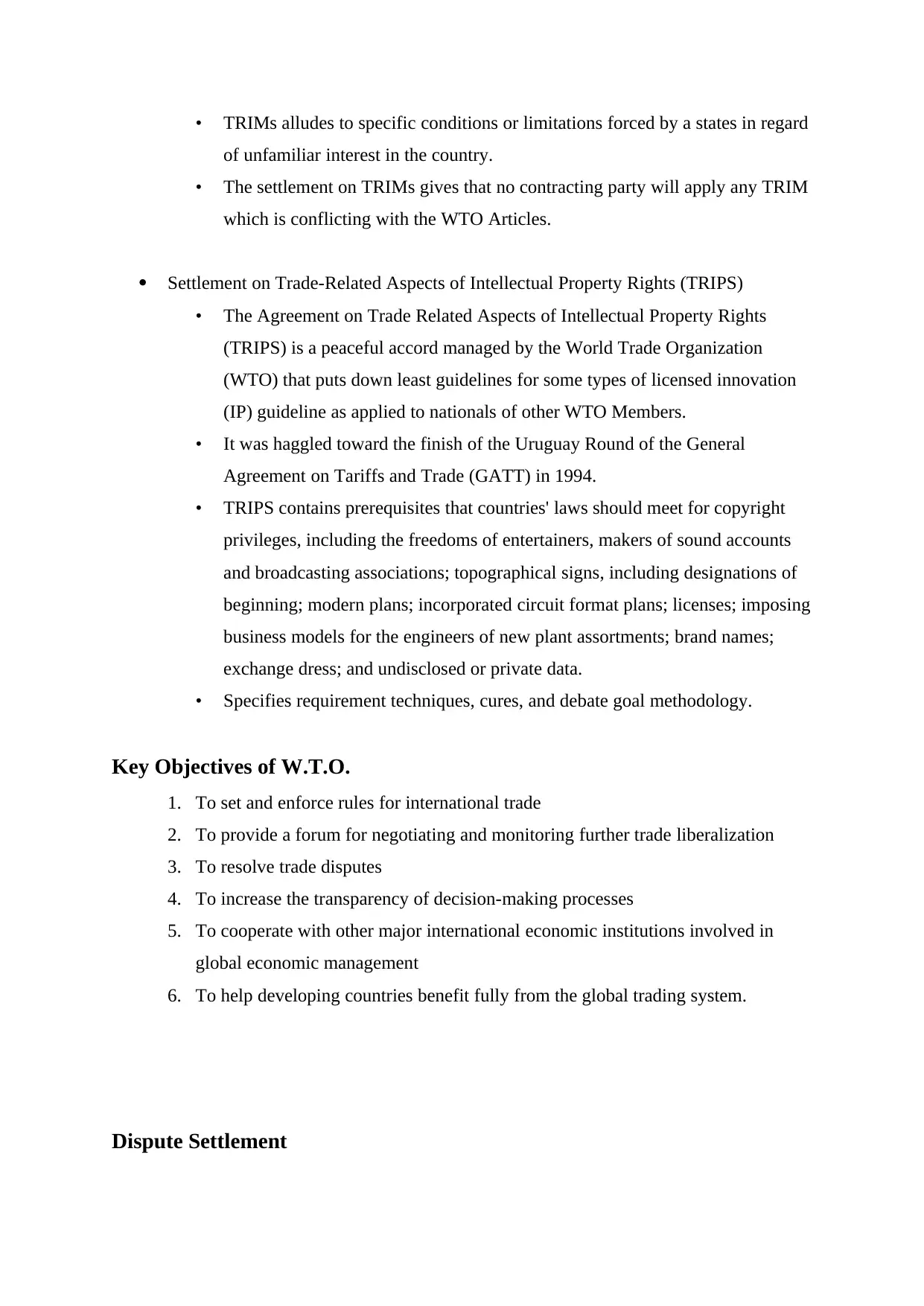
• TRIMs alludes to specific conditions or limitations forced by a states in regard
of unfamiliar interest in the country.
• The settlement on TRIMs gives that no contracting party will apply any TRIM
which is conflicting with the WTO Articles.
Settlement on Trade-Related Aspects of Intellectual Property Rights (TRIPS)
• The Agreement on Trade Related Aspects of Intellectual Property Rights
(TRIPS) is a peaceful accord managed by the World Trade Organization
(WTO) that puts down least guidelines for some types of licensed innovation
(IP) guideline as applied to nationals of other WTO Members.
• It was haggled toward the finish of the Uruguay Round of the General
Agreement on Tariffs and Trade (GATT) in 1994.
• TRIPS contains prerequisites that countries' laws should meet for copyright
privileges, including the freedoms of entertainers, makers of sound accounts
and broadcasting associations; topographical signs, including designations of
beginning; modern plans; incorporated circuit format plans; licenses; imposing
business models for the engineers of new plant assortments; brand names;
exchange dress; and undisclosed or private data.
• Specifies requirement techniques, cures, and debate goal methodology.
Key Objectives of W.T.O.
1. To set and enforce rules for international trade
2. To provide a forum for negotiating and monitoring further trade liberalization
3. To resolve trade disputes
4. To increase the transparency of decision-making processes
5. To cooperate with other major international economic institutions involved in
global economic management
6. To help developing countries benefit fully from the global trading system.
Dispute Settlement
of unfamiliar interest in the country.
• The settlement on TRIMs gives that no contracting party will apply any TRIM
which is conflicting with the WTO Articles.
Settlement on Trade-Related Aspects of Intellectual Property Rights (TRIPS)
• The Agreement on Trade Related Aspects of Intellectual Property Rights
(TRIPS) is a peaceful accord managed by the World Trade Organization
(WTO) that puts down least guidelines for some types of licensed innovation
(IP) guideline as applied to nationals of other WTO Members.
• It was haggled toward the finish of the Uruguay Round of the General
Agreement on Tariffs and Trade (GATT) in 1994.
• TRIPS contains prerequisites that countries' laws should meet for copyright
privileges, including the freedoms of entertainers, makers of sound accounts
and broadcasting associations; topographical signs, including designations of
beginning; modern plans; incorporated circuit format plans; licenses; imposing
business models for the engineers of new plant assortments; brand names;
exchange dress; and undisclosed or private data.
• Specifies requirement techniques, cures, and debate goal methodology.
Key Objectives of W.T.O.
1. To set and enforce rules for international trade
2. To provide a forum for negotiating and monitoring further trade liberalization
3. To resolve trade disputes
4. To increase the transparency of decision-making processes
5. To cooperate with other major international economic institutions involved in
global economic management
6. To help developing countries benefit fully from the global trading system.
Dispute Settlement
⊘ This is a preview!⊘
Do you want full access?
Subscribe today to unlock all pages.

Trusted by 1+ million students worldwide
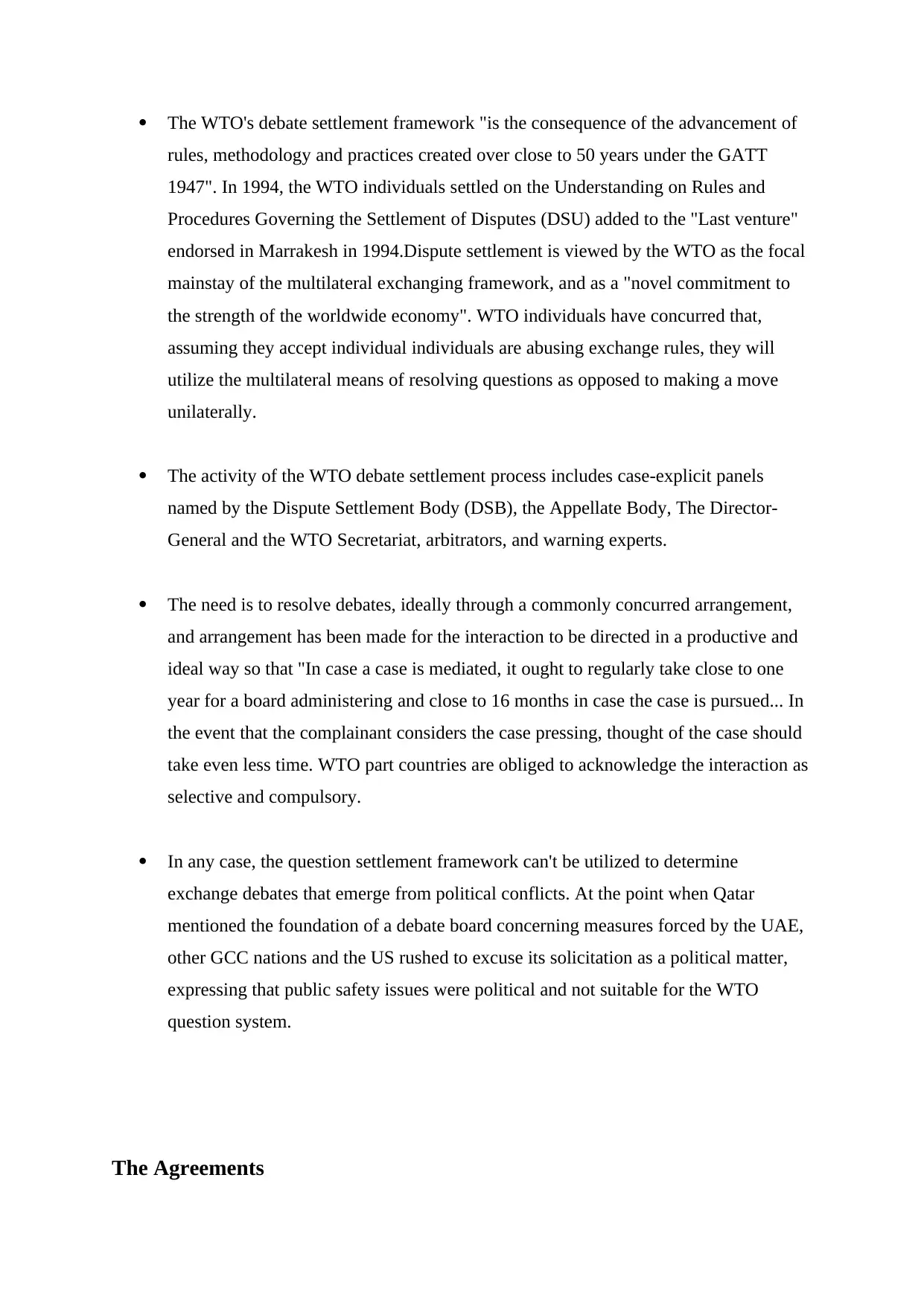
The WTO's debate settlement framework "is the consequence of the advancement of
rules, methodology and practices created over close to 50 years under the GATT
1947". In 1994, the WTO individuals settled on the Understanding on Rules and
Procedures Governing the Settlement of Disputes (DSU) added to the "Last venture"
endorsed in Marrakesh in 1994.Dispute settlement is viewed by the WTO as the focal
mainstay of the multilateral exchanging framework, and as a "novel commitment to
the strength of the worldwide economy". WTO individuals have concurred that,
assuming they accept individual individuals are abusing exchange rules, they will
utilize the multilateral means of resolving questions as opposed to making a move
unilaterally.
The activity of the WTO debate settlement process includes case-explicit panels
named by the Dispute Settlement Body (DSB), the Appellate Body, The Director-
General and the WTO Secretariat, arbitrators, and warning experts.
The need is to resolve debates, ideally through a commonly concurred arrangement,
and arrangement has been made for the interaction to be directed in a productive and
ideal way so that "In case a case is mediated, it ought to regularly take close to one
year for a board administering and close to 16 months in case the case is pursued... In
the event that the complainant considers the case pressing, thought of the case should
take even less time. WTO part countries are obliged to acknowledge the interaction as
selective and compulsory.
In any case, the question settlement framework can't be utilized to determine
exchange debates that emerge from political conflicts. At the point when Qatar
mentioned the foundation of a debate board concerning measures forced by the UAE,
other GCC nations and the US rushed to excuse its solicitation as a political matter,
expressing that public safety issues were political and not suitable for the WTO
question system.
The Agreements
rules, methodology and practices created over close to 50 years under the GATT
1947". In 1994, the WTO individuals settled on the Understanding on Rules and
Procedures Governing the Settlement of Disputes (DSU) added to the "Last venture"
endorsed in Marrakesh in 1994.Dispute settlement is viewed by the WTO as the focal
mainstay of the multilateral exchanging framework, and as a "novel commitment to
the strength of the worldwide economy". WTO individuals have concurred that,
assuming they accept individual individuals are abusing exchange rules, they will
utilize the multilateral means of resolving questions as opposed to making a move
unilaterally.
The activity of the WTO debate settlement process includes case-explicit panels
named by the Dispute Settlement Body (DSB), the Appellate Body, The Director-
General and the WTO Secretariat, arbitrators, and warning experts.
The need is to resolve debates, ideally through a commonly concurred arrangement,
and arrangement has been made for the interaction to be directed in a productive and
ideal way so that "In case a case is mediated, it ought to regularly take close to one
year for a board administering and close to 16 months in case the case is pursued... In
the event that the complainant considers the case pressing, thought of the case should
take even less time. WTO part countries are obliged to acknowledge the interaction as
selective and compulsory.
In any case, the question settlement framework can't be utilized to determine
exchange debates that emerge from political conflicts. At the point when Qatar
mentioned the foundation of a debate board concerning measures forced by the UAE,
other GCC nations and the US rushed to excuse its solicitation as a political matter,
expressing that public safety issues were political and not suitable for the WTO
question system.
The Agreements
Paraphrase This Document
Need a fresh take? Get an instant paraphrase of this document with our AI Paraphraser
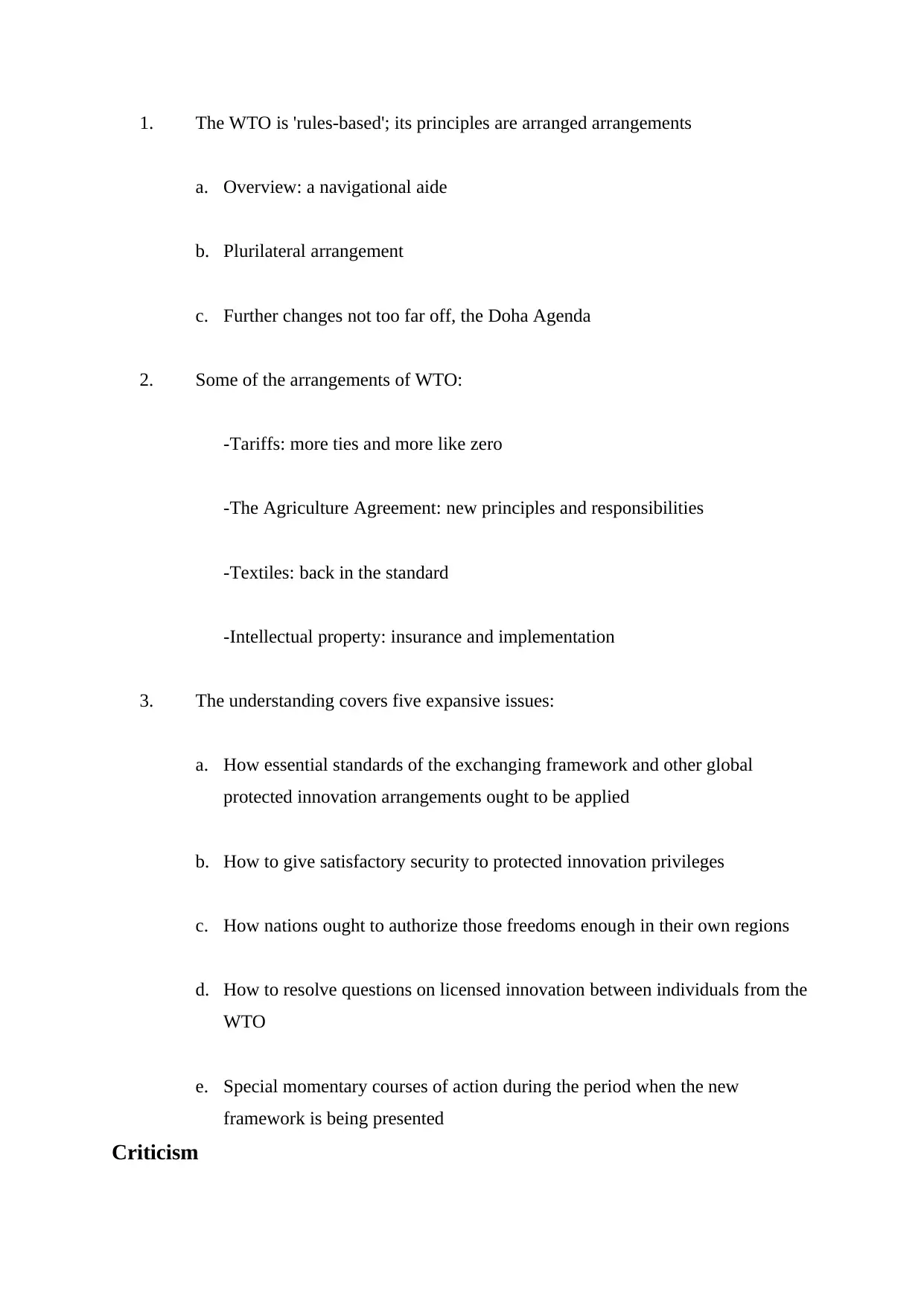
1. The WTO is 'rules-based'; its principles are arranged arrangements
a. Overview: a navigational aide
b. Plurilateral arrangement
c. Further changes not too far off, the Doha Agenda
2. Some of the arrangements of WTO:
-Tariffs: more ties and more like zero
-The Agriculture Agreement: new principles and responsibilities
-Textiles: back in the standard
-Intellectual property: insurance and implementation
3. The understanding covers five expansive issues:
a. How essential standards of the exchanging framework and other global
protected innovation arrangements ought to be applied
b. How to give satisfactory security to protected innovation privileges
c. How nations ought to authorize those freedoms enough in their own regions
d. How to resolve questions on licensed innovation between individuals from the
WTO
e. Special momentary courses of action during the period when the new
framework is being presented
Criticism
a. Overview: a navigational aide
b. Plurilateral arrangement
c. Further changes not too far off, the Doha Agenda
2. Some of the arrangements of WTO:
-Tariffs: more ties and more like zero
-The Agriculture Agreement: new principles and responsibilities
-Textiles: back in the standard
-Intellectual property: insurance and implementation
3. The understanding covers five expansive issues:
a. How essential standards of the exchanging framework and other global
protected innovation arrangements ought to be applied
b. How to give satisfactory security to protected innovation privileges
c. How nations ought to authorize those freedoms enough in their own regions
d. How to resolve questions on licensed innovation between individuals from the
WTO
e. Special momentary courses of action during the period when the new
framework is being presented
Criticism
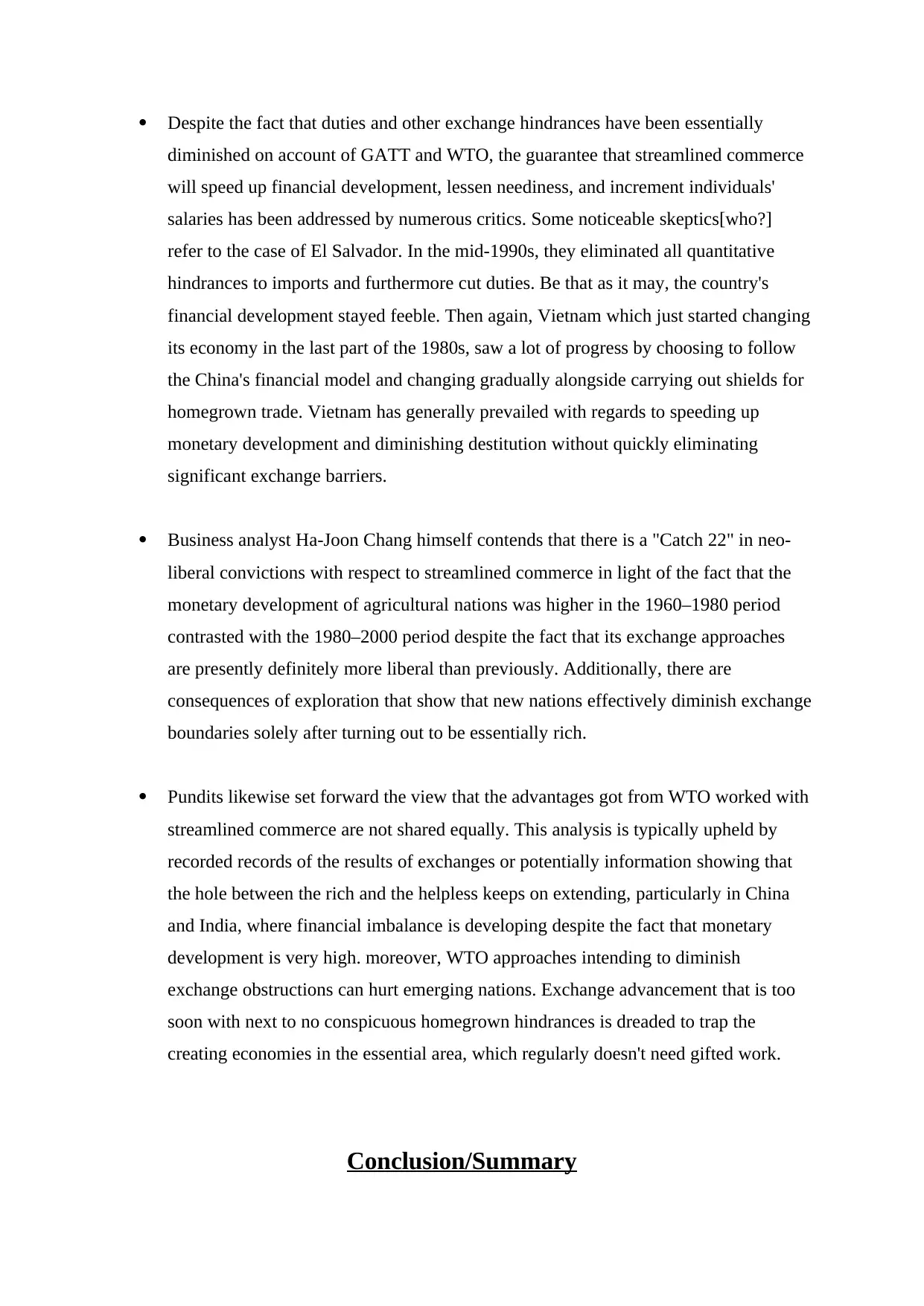
Despite the fact that duties and other exchange hindrances have been essentially
diminished on account of GATT and WTO, the guarantee that streamlined commerce
will speed up financial development, lessen neediness, and increment individuals'
salaries has been addressed by numerous critics. Some noticeable skeptics[who?]
refer to the case of El Salvador. In the mid-1990s, they eliminated all quantitative
hindrances to imports and furthermore cut duties. Be that as it may, the country's
financial development stayed feeble. Then again, Vietnam which just started changing
its economy in the last part of the 1980s, saw a lot of progress by choosing to follow
the China's financial model and changing gradually alongside carrying out shields for
homegrown trade. Vietnam has generally prevailed with regards to speeding up
monetary development and diminishing destitution without quickly eliminating
significant exchange barriers.
Business analyst Ha-Joon Chang himself contends that there is a "Catch 22" in neo-
liberal convictions with respect to streamlined commerce in light of the fact that the
monetary development of agricultural nations was higher in the 1960–1980 period
contrasted with the 1980–2000 period despite the fact that its exchange approaches
are presently definitely more liberal than previously. Additionally, there are
consequences of exploration that show that new nations effectively diminish exchange
boundaries solely after turning out to be essentially rich.
Pundits likewise set forward the view that the advantages got from WTO worked with
streamlined commerce are not shared equally. This analysis is typically upheld by
recorded records of the results of exchanges or potentially information showing that
the hole between the rich and the helpless keeps on extending, particularly in China
and India, where financial imbalance is developing despite the fact that monetary
development is very high. moreover, WTO approaches intending to diminish
exchange obstructions can hurt emerging nations. Exchange advancement that is too
soon with next to no conspicuous homegrown hindrances is dreaded to trap the
creating economies in the essential area, which regularly doesn't need gifted work.
Conclusion/Summary
diminished on account of GATT and WTO, the guarantee that streamlined commerce
will speed up financial development, lessen neediness, and increment individuals'
salaries has been addressed by numerous critics. Some noticeable skeptics[who?]
refer to the case of El Salvador. In the mid-1990s, they eliminated all quantitative
hindrances to imports and furthermore cut duties. Be that as it may, the country's
financial development stayed feeble. Then again, Vietnam which just started changing
its economy in the last part of the 1980s, saw a lot of progress by choosing to follow
the China's financial model and changing gradually alongside carrying out shields for
homegrown trade. Vietnam has generally prevailed with regards to speeding up
monetary development and diminishing destitution without quickly eliminating
significant exchange barriers.
Business analyst Ha-Joon Chang himself contends that there is a "Catch 22" in neo-
liberal convictions with respect to streamlined commerce in light of the fact that the
monetary development of agricultural nations was higher in the 1960–1980 period
contrasted with the 1980–2000 period despite the fact that its exchange approaches
are presently definitely more liberal than previously. Additionally, there are
consequences of exploration that show that new nations effectively diminish exchange
boundaries solely after turning out to be essentially rich.
Pundits likewise set forward the view that the advantages got from WTO worked with
streamlined commerce are not shared equally. This analysis is typically upheld by
recorded records of the results of exchanges or potentially information showing that
the hole between the rich and the helpless keeps on extending, particularly in China
and India, where financial imbalance is developing despite the fact that monetary
development is very high. moreover, WTO approaches intending to diminish
exchange obstructions can hurt emerging nations. Exchange advancement that is too
soon with next to no conspicuous homegrown hindrances is dreaded to trap the
creating economies in the essential area, which regularly doesn't need gifted work.
Conclusion/Summary
⊘ This is a preview!⊘
Do you want full access?
Subscribe today to unlock all pages.

Trusted by 1+ million students worldwide
1 out of 14
Related Documents
Your All-in-One AI-Powered Toolkit for Academic Success.
+13062052269
info@desklib.com
Available 24*7 on WhatsApp / Email
![[object Object]](/_next/static/media/star-bottom.7253800d.svg)
Unlock your academic potential
Copyright © 2020–2025 A2Z Services. All Rights Reserved. Developed and managed by ZUCOL.





